Snapdragon 800 (MSM8974) Performance Preview: Qualcomm Mobile Development Tablet Tested
by Brian Klug on June 18, 2013 8:00 PM EST3DMark
3DMark for Android features the Ice Storm benchmark and uses OpenGL ES 2.0. Ice Storm is divided into two graphics tests and a physics test. The first graphics test is geometry heavy while the second test is more pixel shader intensive. The physics test, as you might guess, is CPU bound and multithreaded. The overall score takes into account both graphics and physics tests. The benchmark is rendered to an offscreen buffer at 720p/1080p and then scaled up to the native resolution of the device being tested. This is a very similar approach we've seen by game developers to avoid rendering at native resolution on some of the ultra high resolution tablets. The beauty of 3DMark's approach here is the fact that all results are comparable, regardless of a device's native resolution. The downside is we don't get a good idea of how some of the ultra high resolution tablets would behave with these workloads running at their native (> 1080p) resolutions.
For these benchmarks we stuck with the default presets (720p, normal quality).
Here the key comparisons are against the Adreno 320 based HTC One/SGS4 (T-Mobile) and the PowerVR SGX 544MP3 based SGS4 (SHEVE300S). The Nexus 10 is interesting but pretty much a blowout. Snapdragon 800 is clearly the new high-end Android tablet SoC of choice.
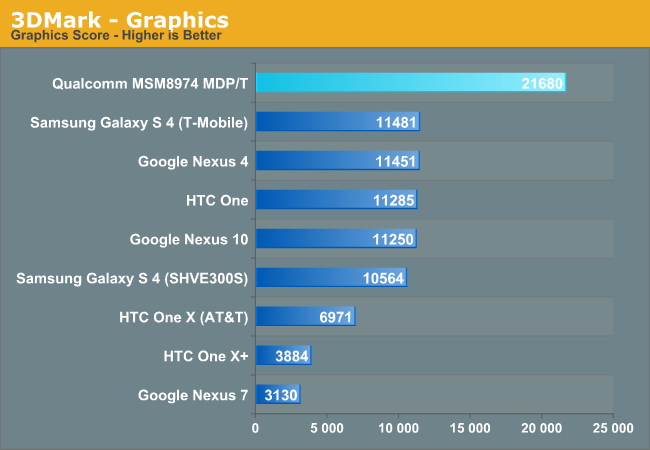
The overall graphics score from Adreno is amazing. We're looking at almost 2x the next fastest contender here, the Adreno 320 based Snapdragon 600.
Graphics Test 1
Ice Storm Graphics test 1 stresses the hardware’s ability to process lots of vertices while keeping the pixel load relatively light. Hardware on this level may have dedicated capacity for separate vertex and pixel processing. Stressing both capacities individually reveals the hardware’s limitations in both aspects.
In an average frame, 530,000 vertices are processed leading to 180,000 triangles rasterized either to the shadow map or to the screen. At the same time, 4.7 million pixels are processed per frame.
Pixel load is kept low by excluding expensive post processing steps, and by not rendering particle effects.

Graphics Test 2
Graphics test 2 stresses the hardware’s ability to process lots of pixels. It tests the ability to read textures, do per pixel computations and write to render targets.
On average, 12.6 million pixels are processed per frame. The additional pixel processing compared to Graphics test 1 comes from including particles and post processing effects such as bloom, streaks and motion blur.
In each frame, an average 75,000 vertices are processed. This number is considerably lower than in Graphics test 1 because shadows are not drawn and the processed geometry has a lower number of polygons.
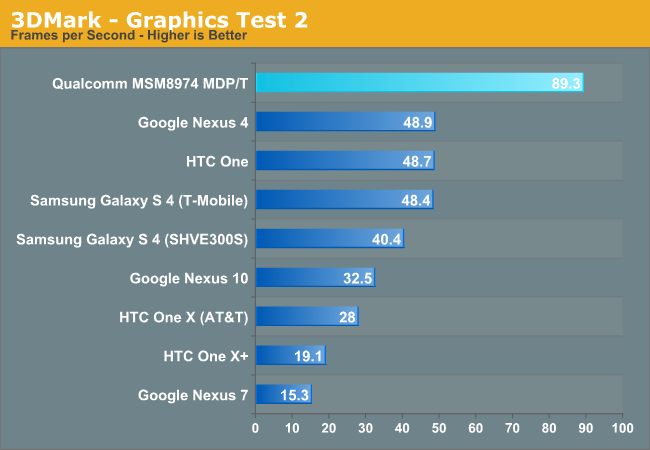
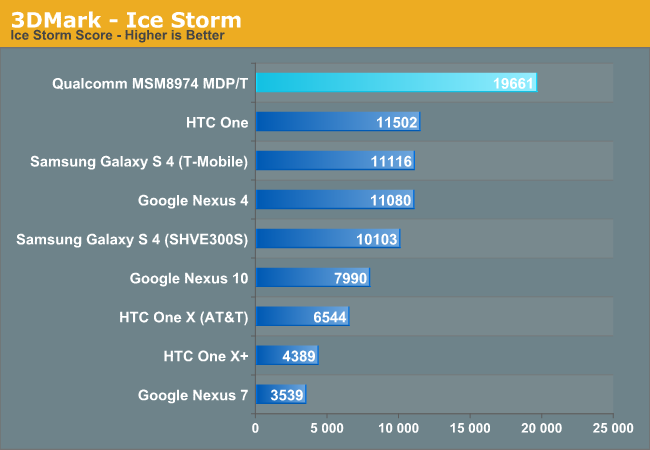
The overall Ice Storm score shows a 71% improvement over Snapdragon 600, which is the closest competitor.
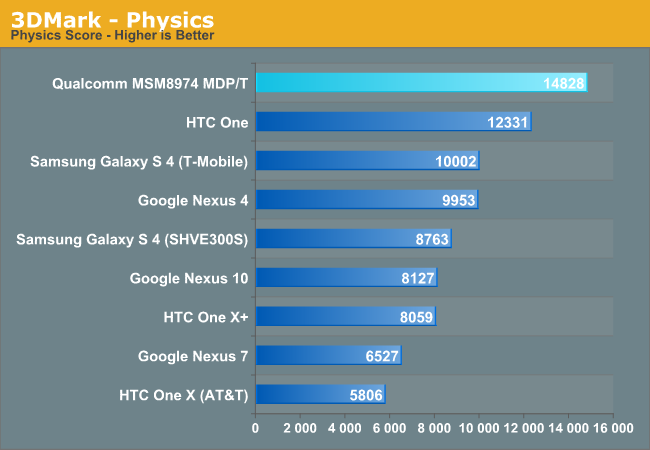
The physics test takes multicore CPU performance into account, but even then the Snapdragon 800 remains ahead of the pack. The performance advantage over the lower clocked Snapdragon 600 shrinks to just 20%, which is a bit lower than clock speeds alone would normally tell us.
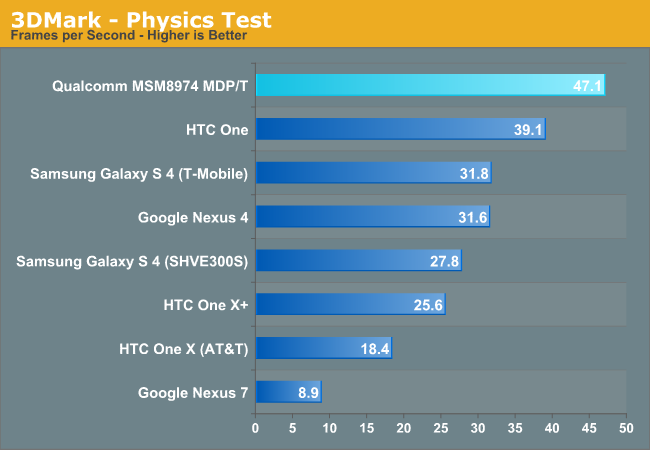










115 Comments
View All Comments
Parhelion69 - Thursday, June 27, 2013 - link
Why is it Android CPU benchmark broken? Please enlighten me.I thought Antutu was a very good benchmark. And probably Geekbench as well.
darkice1111 - Tuesday, July 9, 2013 - link
Great performance. Now if only we could get some more software optimizations on Android... My iPhone 5 iOS 7 beta 3 results: Sunspider 1.0 - 709.0ms; Kraken - 13783.9ms; Octane v1 - 3056; Browsermark 2.0 - 3056. So 9 month old dual core hardware that's faster than anything on the market today, and faster in some benchmarks than something that's not even on the market yet... Google, wasssssssup??sna1970 - Tuesday, July 9, 2013 - link
Hi,How About comparing this to Nvidia Tegra 4 ?
MaxH - Tuesday, October 1, 2013 - link
Thanks Brian for a great test of this chipset. I am especially interested in the video encoding performance, and your inclusion of the 'MediaInfo' screen capture is really useful to see how it is encoding H.264 video.Your MediaInfo clip clearly shows that this chipset can encode H.264/AVC at 2160p @ 25fps @ 120Mbps, (Baseline @Level 5.1). As a low-budget film-maker, I am speculating about the possibility that the encoder could alternatively be configured to handle 1080p @ 30fps (perhaps 60fps) @ 4:2:2 colour sampling @ 10-bit (perhaps 12-bit) depth. I have not been able to get confirmation of this, but if so - at this price point, this chipset could potentially unlock high quality video capture on regular consumer-level DSLR-type cameras; something that has been limited to commercial broadcast cameras (at high-budget prices) up to now. If anyone is familiar enough with AVC profiles and Levels (and related matters) to be able to speculate about this, I would like to hear your thoughts. Thanks again to Brian.
Netwern - Tuesday, December 31, 2013 - link
Meanwhile Apple engineers...